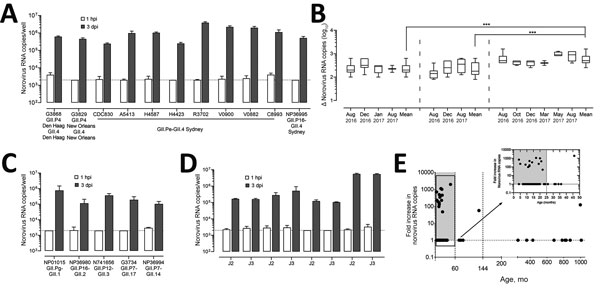Volume 24, Number 8—August 2018
Research
Human Norovirus Replication in Human Intestinal Enteroids as Model to Evaluate Virus Inactivation
Figure 3

Figure 3. Evaluation of human norovirus replication in human intestinal enteroids (HIEs). A) Jejunal HIE monolayers (J3 line) inoculated with GII.4 P4 Den Haag-GII.4 Den Haag (6.2 × 104 RNA copies/well), GII.4 P4 New Orleans-GII.4 New Orleans (5.3 × 105 RNA copies/ well), GII.4 P16-GII.4 Sydney (1.5 × 106 RNA copies/well) or GII.4 Pe-GII.4 Sydney (1.8 × 105 to 3.0 × 106 RNA copies/well). Each experiment was performed 3 times with 3 technical replicates each. B) Replicated infections with fecal filtrates. GII.4 P4 Den Haag-GII.4 Den Haag (6.2 × 104 RNA copies/well), GII.4 P4 New Orleans-GII.4 New Orleans (5.3 × 105 RNA copies/well), GII.4 Pe-GII.4 Sydney (1.8 × 105 RNA copies/well) were included as positive controls throughout 1 year to assess the reproducibility of the HIE culture system. Data are shown as log increase in norovirus RNA per well at 3 dpi compared with 1 hpi. Boxes represent 25th percentile, median, and 75th percentile, and whiskers show minimum and maximum values. Each box represents all experiments performed during the indicated month (GII.P4 New Orleans-GII.4 New Orleans, n = 4–8, total: 18; GII.P4 Den Haag-GII.4 Den Haag, n = 6–15, total: 33; GII.Pe-GII.4 Sydney, n = 6–20, total: 35). ***p<0.0001 comparing log increase in norovirus RNA between 2 GII.4 variants. C) Jejunal HIE monolayers inoculated with NP01015 (GII.Pg-GII.1) at 4.8 × 106 RNA copies per well, NP36980 (GII.P16-GII.2) at 1.51 × 106 RNA copies/well, N741656 (GII.P12-GII.3) at 1.5 × 106 RNA copies/well, G3734 (GII.P7-GII.17) at 2.0 × 103 RNA copies/well or NP36994 (GII.P7–GII.14) at 5.9 × 106 RNA copies/well. Data represent mean ± SD of 3 experiments with 3 technical replicates for each experiment. D) Jejunal HIE monolayers (lines J2 and J3) inoculated with G3734 (GII.P7-GII.17) at 2.0 × 103 RNA copies/well, N741656 (GII.P12-GII.3) at 1.5 × 106 RNA copies/well, NP36980 (GII.P16-GII.2) at 1.51 × 106 RNA copies/well, or R3702 (GII.P16-GII.4 Sydney) at 7.7 × 106 RNA copies/well. Data represent mean ± SD of 2 experiments with 3 technical replicates for each experiment. E) Relationship between age of patient from whom fecal sample was collected and success of replication in HIE. We collected 80 fecal samples during 2000–2017 from children <12 years of age (n+62) and from adults (n=18). No replication is indicated as 1. For panels A, C, and D, dotted lines represent quantitative RT-qPCR limit of detection. dpi, days postinfection; hpi, hours postinfection.